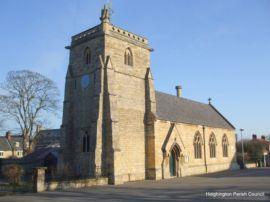
Potterhanworth Road
Heighington
Lincoln
Lincolnshire
LN4 1RJ
Rector: Father Yuce Kabakci
Parish Wardens (based at St John's, Washingborough):
Colin Ward & Jonathan Clark - churchwardens@washingboroughgroup.org.uk
Click on this link to The Washingborough Group of Churches for Service Information
St.Thomas Church, The Chapel-of-Ease, Heighington - a short history and explanation of the origins, history, and modern times of this most unusual Church of England Chapel
For the interest of all the people who have come to visit us or to live in the area in the last few years, I thought it would be nice to write a few notes on the building, why we are and always have been part of the Parish of Washingborough,and why we are also separate. In the old days a church or chapel which was separate from the direct control of the diocese was called a “peculiar”and there is nothing more peculiar,if not unique than St. Thomas’s.
The “Township of Heighington” has always been part of the Parish of “Washingborough with Heighington”. In Norman times a Parish was set up and a Parish Church was built, (possibly on or near the site of an Anglo-Saxon church). At some time, possibly around 1200A.D.a place of worship was established in Heighington. Due to the vagaries of geography and the weather these places were established in outlying parts of parishes, and were called “Chapels of Ease”, as they made it easier for the people to get to church.(The Victorians would have called them Mission Churches). You were not allowed by law to have two main churches in one Parish. To build a Chapel of Ease you would need the agreement of the Diocesan authorities and the incumbent and anyway the people who put up the money to build the Parish Churches and pay the Clergy were not too keen to have to split the income two or more ways! Consequently Chapels of Ease were not common.
Heighington Chapel of Ease survived into the 1600s, when, although still being used was falling into disrepair. At this time the fens were being drained and the “Merchant Adventurers” who were funding and organising the work became rich men. One of these men was Thomas Garratt. He Bought the Chapel of Ease from the Crown. Apparently he used some of it for his own purposes, but services were still held in the Chapel. In Thomas Garratt’s will he set up a Trust Fund to found a school in the building for the boys of Heighington, Washingborough, and Branston, (in 1620) which for many years ran as a Grammar School with pupils from all over the country. This Trust fund is the Thomas Garratts Charity and the Rector of Washingborough is automatically one of the Trustees,and who is also tasked with taking services in the Chapel under the terms of the Will.
The situation was, AND STILL IS, that the building is not owned by the Church of England but by the Trust.
With the exception of the tower, up to the 1860s the chapel was made of brick. (No one knows what the original construction was and when it was rebuilt with bricks). By this time the then Rector decided that a “proper” Church was needed and work began to change it to the form which the Chapel is today. Education was becoming more important both locally and nationally so at the same time the school rooms were added at the back. The work was completed in 1865 and the school moved into the new rooms but still used the Chapel. The County Council eventually took over the running of the school, which became the Village Boys school. This remained the situation until 1975 when the school was closed and the boys moved into the then new “Millfield” school, (together with the girls who moved from where the “Jubilee Hall” now stands). For many years the Parish of Washingborough with Heighington had a Curate who was also the Headmaster, and he lived next to the Manor House. The house is still called ”School House”.
The closure of the school, and the requirement for the Trustees to follow the terms of Thomas Garratts will led to an odd situation over the use of the school rooms. However in the early 1990s the then new Rector, (Rev Adrian Bell) and the other Trustees met with the Charity Commissioners and the charity evolved to its current form. At the same time, North Kesteven District Council were looking for sites for “Heritage Rooms”, and so the school rooms were leased to them for 25 years.
There never was a graveyard attached to the Chapel, all burials were, and still are in the Parish Church graveyard at Washingborough. However when the Chapel also became a school, land was set aside. This land became the schoolyard, and while the school was still using the building the County Council helped with the maintenance of it. That is why we are lucky to have a large area for car parking and why the older villagers still call it the schoolyard.
The Chapel had never been dedicated to any particular Saint (as far as is known), and was, and still is, known affectionately as the Chapel of Ease by the villagers. To outsiders this caused confusion. The congregation at the Chapel of Ease has grown considerably over the last few years, and the Rector and Trustees felt that as it had always been regarded as the village church it should be accorded that status. Consequently in 1993 the Bishop of Lincoln dedicated the building to St Thomas and it became “St.Thomas’s” church. At one time an ancient Cross stood on Chapel Lane. This was dedicated to St. Martin. There was discussion whether the chapel should be dedicated to St Martin, but eventually St. Thomas was chosen because of Thomas Garratt and all the doubts over the years about its continuing existence.
